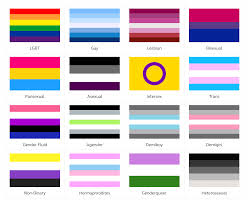Here are a few of the LGBT+ flags. Many have gone through years of changes, but the rainbow flag is universal for the entire community. (Photo courtesy of Wikimedia Commons).
Millennials and Gen Z kids cause a lot of changes in our modern vocabulary. Striving to be inclusive and “politically correct”, they’ve normalized vernacular that was once taboo — or didn’t even exist.
With this updated vocabulary, there are bound to be slip-ups — my own parents are guilty of it. It’s partially due to their raisins, but some adults feign ignorance instead.
Here’s my condensed guide of modern terminology and ideologies that cause some confusion, especially when it comes to the LGBT+ community.
Gender vs. Sex:
It’s essential to understand the difference between gender and sex. Gender is a spectrum — there is no definite number or binary construct for it: it is simply how someone identifies.
Sex on the other hand, is genetic. Biologically speaking, there are 5 recognized genetic sexes, but there can easily be more. Sex is the different combinations of X and Y chromosomes within a person’s genome — purely scientific.
That distinction is critical when thinking about gender vs. sex: Gender is how a person identifies and feels within themselves, while sex is just the body a person was born into — it certainly isn’t a binding contract.
Cisgender:
adjective
- denoting or relating to a person whose sense of personal identity and gender corresponds with their birth sex.
Back in 2015, a series of government ordinances regarding LGBT+ protections passed, including one regarding bathrooms. At the time, folks would use the bathroom that matches their gender identity — regardless if the individual was transgender. With years of heated debate, the difference between cisgender and transgender needed to be cleared up.
Now you’ll see the term cisgender pop up all around — on college applications, as a descriptor (often shortened to being “cis”), or on other legal forms. It’s both a formality to ask such a question, but could also be used as a weapon against the transgender community. Regardless, it’s essential to respect everyone’s gender, whether they’re cis or trans, they’re still a human being.
Sexual orientation:
People often use the outdated term “sexual preference” when referring to the LGBT+ community. However, this term is loaded with offense and condescension. By using the word “preference”, it implies that said member of the community chose their orientation.
There are always people who wish to experiment, explore, and be fluid in society. However, nobody chooses to LGBT+ — trust me — including those who wish to experiment. Doubts, internalized homophobia, fear, and judgement are just a few things LGBT+ members of all age experience. Our dispositions are not a “preference”: They’re our orientation.
Enby:
|EN’bee|
from “NB”, which stands for non-binary. These people do not identify with the male or female genders, and usually prefer “they” as a pronoun. They are neither men nor women, and should not be regarded as such.
Enbies can be genderqueer, agender, pangender, or any gender identity that is not binary.
Enby is just a shorter way of saying someone is non-binary. Just like the definition, folks who identify as non-binary don’t identify with typical binary genders, and prefer they/them pronouns, unless told otherwise. Using they/them pronouns has become a normal occurrence — as it should be.
If someone comes out as some form of non-binary or says they prefer they/them pronouns, respect that and use them. It takes adjusting, and doesn’t always sound grammatically correct, but would you rather make someone feel safe and comfortable with themselves, or speak like an AP English essay?
Pronouns:
Specifying pronouns is commonplace now: Business emails, applications, social media bios, and other platforms typically reveal a person’s pronouns. The more you see them, the easier it becomes to recognize and properly use them. PRONOUNS AREN’T AUTOMATICALLY BINARY TO A PERSON’S SEX.
Just like with Enbies using they/them pronouns, plenty of people identify with pronouns that don’t match their sex. But there is nothing wrong with that, because if going by certain pronouns makes them feel comfortable, they have the right that comfort.
There are hundreds of other issues I could address, but these few should clarify some initial confusion. If you have questions, please ask — do the research, read the stories — so you can open yourself up to accepting the community for who they are.
At the end of the day we are all human, we will all slip up.
If you can admit you’ve slipped up and work to change, that’s all that matters. Don’t close your mind to the diversity that surrounds you, even if you don’t fully understand it.

Hi! My name is Ellie and I’m a senior editor, trending editor, and print editor for The Mycenaean. I am also a second degree blackbelt at Triangle’s best karate, floral assistant, and a self-proclaimed starving artist. Just a chaotic libra whose only personality trait is how often she dyes her own hair

Leave a Reply